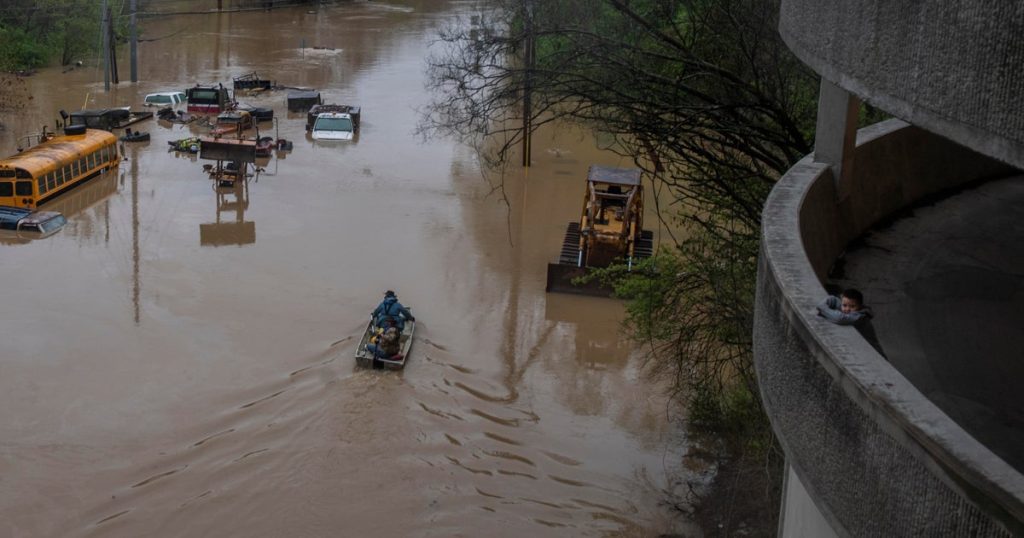Severe weather conditions marked by relentless torrential rain and storms have caused substantial devastation across seven states in the United States, resulting in at least 22 fatalities. The situation has escalated as rivers have reached near-record flood levels, inundating communities primarily in the South and parts of the Midwest. As recovery efforts are underway, officials are working alongside local agencies to assess damage and coordinate emergency responses.
| Article Subheadings |
|---|
| 1) Storm Impact and Fatalities Across States |
| 2) Emergency Responses and Evacuations |
| 3) Record Rainfall and Flooding Events |
| 4) Community Responses and Resilience |
| 5) The Way Forward: Recovery and Assistance |
Storm Impact and Fatalities Across States
The recent wave of storms has been particularly devastating, leading to the deaths of at least 22 individuals across multiple states. Tennessee has been the hardest hit, with ten fatalities reported as a result of extreme weather conditions. Local authorities indicated that the county faced not only heavy downpours but also numerous tornadoes that added to the chaos. For instance, one tragedy involved a 5-year-old boy in Arkansas who perished when a tree collapsed onto his family’s home, while a 16-year-old volunteer firefighter in Missouri lost his life during a rescue mission affected by the storm.
Emergency Responses and Evacuations
In response to rising floodwaters, local officials have enacted evacuation orders in vulnerable areas. Rescue teams equipped with inflatable boats have been dispatched to check on residents in cities like Frankfort, Kentucky, and regions throughout Tennessee. As the situation escalated, power and gas utilities were turned off for safety reasons, and the Tennessee Emergency Management Agency began working diligently with local and federal responders to assess the extent of the damages. The looming prospect of federal disaster declarations has prompted citizens to report their losses to emergency management offices, bolstering possibilities for relief and recovery.
Record Rainfall and Flooding Events
The rainfall events have surpassed records, bringing chaos to towns and cities alike. In Jonesboro, Arkansas, more than five inches of rain fell in just one day, marking the wettest April day ever recorded for the area. Meanwhile, Memphis, Tennessee reported an astounding total of 14 inches from the storm that launched on Wednesday and persisted through the weekend. Many towns, such as Rives, Tennessee, were submerged, pushing residents to seek shelter and safety as the waters rose alarmingly high. In some areas, residents even expressed concern regarding the efficacy of local flood prevention systems, demonstrating a growing sense of urgency and fear about future storms.
Community Responses and Resilience
In the face of adversity, communities have displayed remarkable resilience. Local businesses and organizations have stepped up to assist those impacted. For instance, a hotel in Frankfort offered discounted accommodations to locals who lost their homes or faced evacuation due to rising waters. Residents not only shared resources, but also rallied to help each other. Among the evacuees was 77-year-old George Manns, who gathered essentials and headed for a storm shelter after receiving a warning. Such actions showcase not only individual efforts but also a strong community spirit in trying times.
The Way Forward: Recovery and Assistance
Recovery programs are already being formulated as communities begin to assess the full impact of the storms. Local and federal agencies will play critical roles in the aftermath, with many officials optimistic that existing frameworks can expedite the recovery process. Moreover, the Federal Emergency Management Agency (FEMA) may assist in coordinating long-term recovery efforts, depending on findings laid out in the assessments conducted by state emergency management agencies. However, the road ahead will likely prove to be challenging, with rebuilding efforts taking time and considerable resources.
| No. | Key Points |
|---|---|
| 1 | Relentless storms resulted in at least 22 fatalities across several states. |
| 2 | Evacuations and emergency responses have commenced in various flood-affected areas. |
| 3 | Record levels of rainfall were recorded in cities like Jonesboro and Memphis. |
| 4 | Communities have come together, showing solidarity and support during crises. |
| 5 | Plans for recovery and federal assistance are already being outlined as damage assessments begin. |
Summary
The recent storms have unleashed unprecedented devastation, emphasizing the fragility of communities in the face of nature’s fury. With significant casualties reported and ongoing flood risks, the path to recovery will require concerted efforts from local, state, and federal agencies. The solidarity exhibited by communities in support of one another serves as a powerful reminder of resilience in trying times. As assessments continue and recovery plans take shape, it is imperative to remain aware of both the immediate and long-term needs of affected individuals and towns.
Frequently Asked Questions
Question: What regions are most affected by the storms?
Regions predominantly in the South and parts of the Midwest are experiencing significant impacts from the storms, particularly in states like Tennessee, Kentucky, Arkansas, and Missouri.
Question: How are local governments responding to the flooding?
Local governments are issuing evacuation orders, deploying emergency responders, and collaborating with federal agencies to assess damage and organize recovery efforts.
Question: What measures are being taken to prevent future flooding disasters?
After reviewing the responses to recent flooding, officials will likely assess and enhance flood prevention infrastructure and preparedness measures to minimize future risks and improve community resilience.


